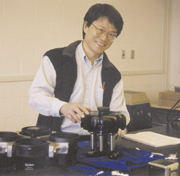
 |

|
|
 |
|
|
|||
 Adrian Tsang is leading a team of researchers to isolate fungal enzymes that could contribute to biological alternatives in various industrial processes. Their work holds promise for environmental improvement in the pulp and paper industry. File Photo |
by Barbara Black Genomics research at Concordia was given a giant boost last week when it was announced that more than $7.5 million — $7,512,709, to be exact — is being given by Genome Canada and Génome Québec to finance an exciting environmental biotechnology project. Professor Adrian Tsang is the principal investigator, although he will have a lot of help from other faculty members in three departments and three other Montreal institutions. Concordia has the greatest number of researchers on the project. The researchers will use genomic techniques to find biological alternatives to deal with various industrial processes, particularly in Canada’s huge pulp and paper industry. Tsang explained in an interview that while paper is enormously versatile — it is found these days not only in newspapers and books, but in diapers and food containers — the production process uses expensive chemicals that can foul our air and waterways. “Bleach is used in the manufacture of white paper, for example,” Tsang said. “Newsprint just involves the power costs, but you notice how it goes brown when it’s exposed to the light and air? That’s the lignin in the fibres. They have to bleach that out to make better paper.” Lignin is a complex organic polymer in the cell walls of many plants that adds strength. It also contributes to fungal-pathogen resistance. “When you go into the woods,” Tsang continued, “you often see mushrooms — fungi — growing on the side of trees, right up against the wood fibre. “The enzymes in the mushroom are chewing up the lignin.” The investigators plan to isolate and test the enzymes that would be just right for breaking down the lignin as part of the paper-making process. They will look at 14 fungi over three years, analyzing between 70,000 and 80,000 genes over that time. The work involves gene-chip technology by which wood-degrading fungal samples are examined to see which enzymes are activated under given conditions and to help understand how fungi degrade wood constituents. “We already know some of the [relevant] enzymes,” Tsang explained. “We will look for those that are similar, and for enzymes with new activities.” When the enzymes of potential commercial value are identified, they will be reproduced in large quantity in a “cell factory,” and tested to see if their properties make them suitable for industrial use. Tsang said that enzymes are already being used in some products — to reduce the foam in household detergents, for example — but the pulp and paper industry has specific and exacting requirements. The enzymes they use must be effective at high temperatures, be affordable, act quickly, and be compatible with other chemicals still being used in the process. This is not hypothesis-driven research — in fact, it’s a hunt for buried treasure — but Tsang and his colleagues are sure they’re going to find the enzymes they want, because this project builds on many years of previous research, and the development of proven investigative techniques. One of the toughest tasks may be purely administrative, Tsang admitted with a laugh. He must coordinate between 40 and 50 researchers on the project, including graduate students, postdoctoral fellows and faculty members, among whom the most senior are Justin Powlowski and Paul Joyce (Chemistry/Biochemistry) and Gregory Butler (Computer Science). Soon Concordia’s Centre for Structural and Functional Genomics will have its own quarters in the new Science Complex on the Loyola Campus, but for now, it is based in the Hnery F. Hall Building. The Genomics Centre is linked to other universities and research centres across the province as part of the Génome Québec network. There are four other similar networks across Canada, linked to Genome Canada. Concordia’s Genomics Centre was launched two years ago with $1.25 million each from the federal and Quebec governments, and $1.1 million from Biochem Pharma of Laval. The other institutions associated with this project are the Pulp and Paper Institute of Canada, the Institut National de la recherche scientifique (Armand Frappier) associated with the Université du Québec, and the National Research Council of Canada’s Biotechnology Research Institute, which is interested in the manufacture of fine chemicals, such as fragrances. |